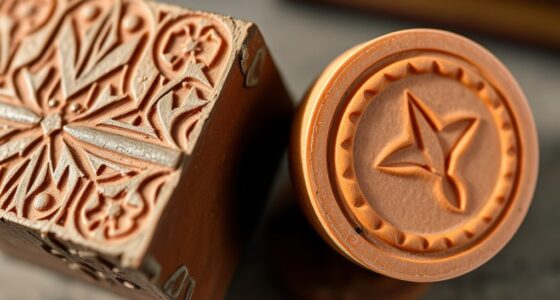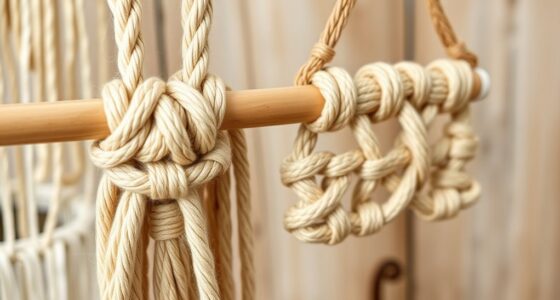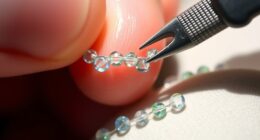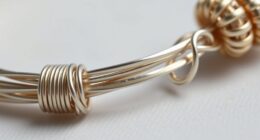When comparing Cricut and Silhouette, you’ll find Cricut offers default settings that deliver consistent, precise cuts with minimal adjustments, making it easy for detailed projects. Silhouette provides adjustable blade settings and custom material guides, allowing more control but requiring some tweaking for different materials. Both machines handle a variety of textures and thicknesses well, but your choice depends on your needed precision and convenience. To discover helpful tips and detailed guides, keep exploring as you plan your next project.
Key Takeaways
- Cricut offers standardized default settings optimized for common materials, simplifying setup for beginners.
- Silhouette provides adjustable blade and force settings, allowing customization for various materials and complex designs.
- Material texture and thickness influence cutting settings; both brands require specific adjustments for optimal results.
- Compatibility of blades and mats with different materials impacts cut precision and material waste reduction.
- Using the correct blade type and pressure ensures cleaner cuts and high accuracy across diverse material types.

Cutting precision is another essential factor. Cricut machines generally deliver high accuracy with their fine-point blades, making them ideal for detailed designs and intricate cuts. They typically feature a more consistent cutting depth, which translates into cleaner edges and less material waste. Silhouette machines also provide excellent precision, especially with their auto-blade system and adjustable blade settings. They can handle complex designs with sharp detail, but some users find that they may need to tweak settings more often for consistency, especially when working with thicker or textured materials. Overall, both brands offer impressive cutting precision, but Cricut’s default settings tend to give more straightforward results for fine detail work without extensive adjustments. Additionally, the compatibility with various cutting mats and blades can influence the ease of use and results for different projects.
Frequently Asked Questions
Can I Use the Same Blades for Both Cricut and Silhouette Machines?
Blade compatibility between Cricut and Silhouette machines isn’t universal, so you can’t always use the same blades for both. Each brand has specific blades designed for their machines, affecting material compatibility. For example, Cricut blades often work best with Cricut materials, while Silhouette blades are optimized for their own. Always verify your machine’s specifications before switching blades to guarantee proper cuts and avoid damage.
How Do I Adjust Cutting Speed for Different Materials?
To modify cutting speed for different materials, start by calibrating your blade to guarantee precise cuts. Then, use pressure adjustment settings to control how firmly the blade presses down, which affects cutting speed. Increasing pressure for thicker materials may slow your cut, while reducing it for delicate ones speeds things up. Always test on scrap material first to fine-tune your blade calibration and pressure, ensuring clean, accurate cuts every time.
Are There Specific Settings for Layered Designs?
Think of layered designs like building a sandwich—each layer needs precise placement. You should use specific settings for layered design techniques, adjusting blade depth and speed accordingly. To achieve ideal layer alignment, keep your material securely in place and consider using registration marks. This careful approach ensures clean cuts and crisp layers, much like carefully stacking ingredients results in a perfect sandwich.
What Troubleshooting Tips Exist for Machine Malfunctions?
If your machine malfunctions, start by checking the blade for maintenance issues—dull blades or debris can cause problems. Also, perform software troubleshooting by updating your software and restarting your device. Guarantee your settings match your material type, and double-check blade depth and pressure. Regularly cleaning and maintaining the blade, along with keeping your software up-to-date, helps prevent and resolve common machine malfunctions quickly.
How Do I Update Firmware on Each Cutting Machine?
To update firmware on your Cricut or Silhouette, connect your device to your computer with a USB or Wi-Fi. Visit the official website or app for firmware updates, then follow the prompts to download and install. Make sure your blade is compatible with the latest firmware to guarantee smooth operation. Regular firmware updates help improve performance and fix bugs, so check periodically for new versions.
Conclusion
When choosing between Cricut and Silhouette, remember that both offer excellent cutting capabilities once you get to know their settings and materials. Don’t get overwhelmed by the differences—start with small projects and experiment. You’ll quickly find what works best for you. Whether you’re a beginner or a seasoned crafter, enjoying your creativity is what truly matters. So, immerse yourself, have fun, and don’t worry about perfection—your perfect project is just a cut away!









